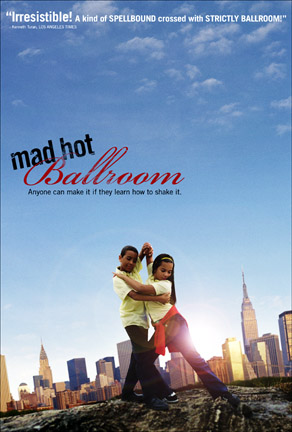
MAD HOT BALLROOM
US, 2005, 106 minutes, Colour.
Pierre Dulaine, Yvonne Marceau, Otto Cappel.
Directed by Marilyn Agrelo.
Strictly Ballroom, Strictly Come Dancing… No problems in finding an audience for a film about dance. This is a very entertaining documentary from New York City where a program of teaching ballroom dancing to young children in schools and entering their teams in competition has been growing since the mid 1990s. As with the very lively documentary about spelling bees and children’s competitions, Spellbound, Mad Hot Ballroom follows the training and preparations of several schools in vastly differing neighbourhoods of Manhattan, Queens and Brooklyn.
You know how it is going to be. We visit the schools, meet the teachers and children, see them in action. We are given explanations of the social difficulties, of the problem children. We listen in to the kids discussing all kinds of topics (especially eagerness or awkwardness with the opposite sex). We do get glimpses of some of the parents but this is an area that could have been more strongly developed. Without the same kind of input from the parents, we do not understand the children as much as we would like. The children themselves, from multi-racial backgrounds, do reveal a lot of how they think and feel.
What of contests? Looking at the disappointed faces of the losers, we wonder at the value of such competitiveness and its effect. The compensating factor is that the children have learned a skill, learned to relate and work as a team and take responsibility.
For those who love the dancing there is plenty, much of it skilled (and some of it not!). Since I lived for a year just down the street in upper Manhattan, Washington Heights, from one of the schools, I knew whom I was supporting: the Indigo team. And they were very good.
1.The popularity of the film? In the context of many dance films? Television ballroom dancing shows?
2.The quality of the documentary, no voice-over, showing the characters, following their lives, the art of dancing, the competitiveness?
3.The dancing, the photography of the dancing and audiences sharing the exhilaration – while sitting in their seats? The program for training the children? The styles and the selection of the dances? The musical score?
4.The focus on the different schools, the different areas of New York City? The social status of each area? The wealth or poverty of the students? The range of teachers and their influence on the children?
5.The presentation of the children, the range of children and their ages, boys and girls? Abilities and lack of ability? Their being difficult at school or good students? Their involvement in the dance training and the competition?
6.The benefits of the training, for character, for manners, for some purpose in life, for some skills? For socialising? For competitiveness, ambition and hoping to win, dealing with loss?
7.Pierre Dulaine, the establishment of the competition, its importance in New York City, for the students? His personality, the personalities of the various people involved in the competition? Their collaboration? Their influence on teachers and children?
8.The teachers, their different personalities, their methods of teaching, example, coping with difficulties?
9.The parents in the background, their interest in their children, their social status? The hopes for the children?
10.A glimpse of a cross-section of New York City, a microcosm?
11.The rehearsals, the traumas and upsets? The thrills and achievement? The competition, tensions, performance? Winners and losers?
12.The build-up to the finals, the participation of the students? The final achievement? The winners from Manhattan and Washington Heights?
13.The audience experience, sharing with the children and understanding them? The achievement of the teachers? An understanding of the variety of social classes in New York City?